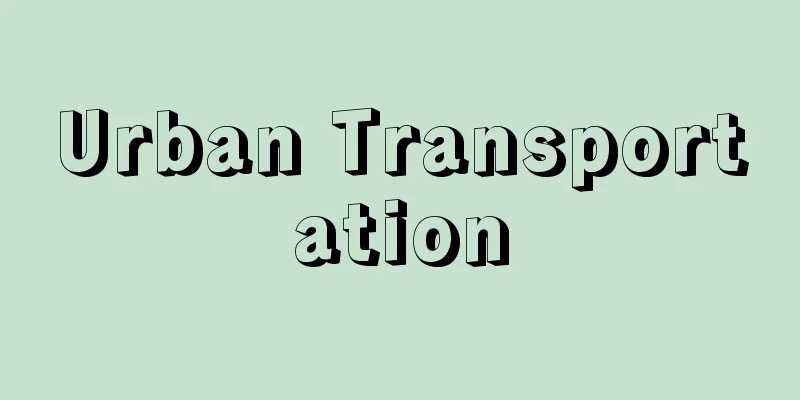Urban Transportation

|
Intra-city traffic is not limited to a single city, but refers to a wider range including the commuting and living areas of local residents as they expand. Therefore, it includes intra-city traffic and suburban traffic. Most of the traffic is short-distance, and the traffic flow is patterned such that business, shopping, and entertainment are centered in the city center, commuting connects the suburbs and the city center, and leisure is centered in the suburbs. Overall, the rush hour phenomenon is significant. In particular, in the case of commuter transportation, the rush hour phenomenon from the suburbs to the city center during the morning rush hour and the reverse rush hour in the evening is severe. The various facilities, vehicles, and labor forces that are specially required for this purpose are only partially utilized during the off-peak hours, and the fares are relatively cheap due to discounts on commuter passes, which creates a certain disadvantage for railway companies. Passengers also become tired due to the congestion. In order to disperse the rush hour phenomenon over time, the so-called "staggered commuting" has been proposed, which sets different starting times for offices and government offices, but it is difficult to implement this on a full scale. Generally, urban transportation has developed in the following order: stagecoach → horse-drawn tramway (mid-19th century) → underground and elevated steam railway (1860s) → streetcars and electric railways → buses and trolleys (20th century) → passenger cars (1920s). In terms of management structure, initially in Europe and the United States there were multiple management bodies, but as passenger cars became more widespread they fell into financial difficulties and as a result many were unified, whereas in Japan there are still multiple management bodies. [Toshio Hirai] Urban Planning and Transportation SystemsRecently, major capitalist countries, including Japan, have been experiencing so-called urban transportation problems, mainly in large urban areas, such as traffic accidents, traffic paralysis, commuter difficulties, traffic pollution, and deficits and declines in public transportation such as streetcars, buses, and railways. The causes are complex, but the main ones, focusing on Japan, are as follows: First, there are characteristics of the development of urban transportation in Japan. That is, after the Meiji era, a transportation system was established centered on railways, sea transport, and river transport, and major streets were considerably developed, but roads for residents' daily lives were left in poor condition. In particular, the spread of horse-drawn carriages was delayed, and the spread of automobiles was suppressed before World War II, so road conditions to accommodate automobiles, such as the division and separation of sidewalks and roads, widening of roads, and paving, were left in poor condition. This was one of the factors that increased the pedestrian fatality rate and intensified traffic pollution and traffic paralysis when motorization progressed rapidly in the 1960s. After the Meiji period, streetcars, national railways (now JR), private railways, buses, etc. were developed considerably, and a radial railway network concentrated at a single point toward the central control functions of politics, economy, culture, and the military in the city center was well developed, but in comparison, the construction of subways lagged behind. [Toshio Hirai] Urbanization and Automobile TrafficSecondly, in addition to these historical characteristics, the following factors intensified urban traffic problems due to the rapid economic growth of the 1960s: [1] Nationwide urbanization (rapid and massive accumulation of capital and labor in large urban areas) and traffic (1) Heavy chemical industry progressed mainly in the coastal industrial areas around large cities, causing a sharp increase in freight transportation, (2) while the central administrative functions of capital occupied the center of the large cities and high-rise buildings were built, a large portion of the residents moved to suburban areas to escape soaring land prices, frequent pollution, and living difficulties, strengthening the tendency to separate work and residence, and (3) administrative investment by the government, especially investment in roads for automobiles, was concentrated in these large urban areas. [2] Rapid progress in motorization Mass production and mass sales of automobiles by large automobile manufacturers, increase in truck transportation, personal cars becoming a daily necessity, and construction of roads for automobiles. [3] Inadequacies and inconveniences of the public transport system Public transport services, which should be the main players in urban transport, have been confined to economically disadvantaged urban areas where automobile traffic is concentrated, due to a decline in the resident population caused by suburbanization of urban population and the paralysis of road transport caused by motorization. Furthermore, they have been bound by the framework of a self-supporting accounting system, and with rising material and labor costs due to inflation and other factors, fares have been kept relatively low due to social policy needs. This has led to serious management crises, with fewer passengers, lower revenues, rising expenses, and increasing deficits. As a result, streetcars have been removed, buses operate irregularly, and subways, which were built to replace them, are virtually unable to support themselves due to the enormous construction costs, and public subsidies are smaller than in other countries, resulting in deficits. Furthermore, major private railways have also faced increased competition from automobiles due to the advancement of motorization, and their share of the passenger transport market has decreased compared to before. Furthermore, as the population moves to the suburbs, the ratio of regular passengers to ordinary passengers within the railways has reversed, making new investments necessary to increase transportation capacity, and the discount rate on regular fares has become a management burden for private railway capital. However, unlike the JR Group and public transportation businesses, major private railways, as the saying goes, "side business is the main business," first secure the transportation of residents through the railway business, and then create a web of more profitable side businesses and secondary businesses along the railway lines, such as land development, department stores, chain stores, real estate, amusement parks, and hotels, and make enormous profits through local monopolies. [Toshio Hirai] Traffic separationVarious policies are being tried around the world to solve the urban traffic problems mentioned above, but the basic approach is, first of all, the separation of traffic. That is, (1) the separation of pedestrian and vehicular traffic, and (2) the separation of intra-regional traffic and through traffic. The most famous in terms of (1) is the Radburn System, which was tried in Radburn, a satellite city of New York, in 1928. In this system, residential areas were established to prevent through traffic, and a sidewalk system was established that completely separated the areas from automobile routes and connected the places where pedestrian traffic was generated, so that pedestrians could safely go to schools, parks, etc. without crossing the roads. The Radburn city that applies this idea to today's automobile age is Cumbernauld in northern England. The most famous in terms of (2) is the zone system in Gothenburg, Sweden's second largest city. In this system, the city center is divided into five zones, and one-way streets and dead ends are used to prevent automobile traffic between the zones, and instead, a ring road is constructed around the city center to make it easy for through traffic to detour. The transport plan for Coventry in the UK is based on the same concept. [Toshio Hirai] Traffic continuityIf the separation of traffic is primarily aimed at safety and comfort, the second direction, the continuity of traffic, aims to make traffic more convenient by connecting the different means of transportation so that they can be easily used. It can be classified as follows: (1) Continuity of people (pedestrians) and cars Like pedestrian-only plazas (shopping parks) in urban areas, they do not simply exclude cars from the area, but ensure that traffic to the area is secured and then connects to pedestrians, ensuring the continuity of traffic. Famous examples include the shopping park in Coventry, England, and Nicollet Mall in Minneapolis, USA, and in Japan there is a shopping park in Asahikawa City. (2) The continuity of cars and mass transit The so-called park and ride or park and bus-ride system, which involves driving one's own car from suburban residential areas to the station and then using a train or bus from the station, aims to increase the convenience of transportation by combining the convenience of the car with the efficiency of mass transit. London's park and ride and Washington's Shirley Highway Express are particularly well-known examples. (3) A continuum of people, cars, and mass transit Munich, Germany, is a typical example. A pedestrian-only plaza was created in the center of the city, with surrounding parking lots for people who come to the area by car and a subway that runs just underneath the plaza for people who come by train. Furthermore, park-and-ride parking lots were created at the suburban stations of the subway. In this way, citizens can conveniently get to the pedestrian-only plaza from their homes via a continuous system of transportation: car → train → escalator. [Toshio Hirai] Time adjustment and common fare systemThirdly, the following policies are in place to separate and continuum transportation from an institutional and operational perspective: (1) Time Adjustments In addition to the staggered commuting schedule already mentioned, there are also flextime systems (a system that allows individuals to work freely outside of the designated working hours (core hours)) and traffic time regulations (systems that automatically change lanes during rush hour). (2) Common fare system In Japan, a common fare system is adopted, whereby a high initial fare is added every time you change from a bus to a train, or from one train to another operated by a different company, and this system impedes the continuity of transportation. However, in Europe, common fare systems are increasingly being adopted instead. This system originated in the Hamburg Transport Association in Germany. In Paris, a common commuter pass (called the "Carte Orange", meaning orange pass) that can be used on any of the 57 privately operated buses with routes totaling 7,000 kilometers in the suburbs has been in use since July 1975. [Toshio Hirai] Unification of urban and transport planningIn addition to the nature of urban transportation itself, fourthly, the unification of urban planning and transportation planning, and even the nature of cities themselves, have recently been given greater importance. (1) Separation and continuity of traffic based on urban planning This is a method of separating and relocating some of the traffic demand that exceeds the capacity of the city to the suburbs. For example, one pillar of the urban redevelopment plan for Paris was to relocate the old wholesale market that had been in the center of Paris since the 19th century near Orly Airport on the outskirts of Paris, and to create the Rungis distribution center (1969). Furthermore, as another pillar, the La Défense district was redeveloped and connected to Charles de Gaulle Station, where the Arc de Triomphe is located, in just under four minutes by subway, promoting the creation of a city where people live and work are close to each other. In Japan, textile wholesalers in Senba, Osaka City, were relocated en masse to the suburban city of Minoh, and the densely packed textile shopping district in Umeda was relocated to "Shin-Osaka Sen'i City." (2) The state of automobile traffic in cities The British report entitled "Automobile Traffic in Cities" (commonly known as the Buchanan Report, 1963) presented two concepts. One is "living environment", which refers to areas throughout the city that are free from the dangers and hazards caused by the intrusion of automobiles, and the other is convenience for automobiles, that is, "reachability". In order to harmonize these two, it is necessary to effectively separate the city into rooms (living environment) and corridors (traffic), and to circulate the traffic smoothly while regulating the traffic volume in the corridors with the rooms at the center (this is called the principle of circulation). From this standpoint, the capacity of the living environment and no-entry zones for automobiles are established. The Radburn method mentioned above is also based on this idea. (3) Creating Livable Cities After the Second World War, urban planning was carried out according to the idea of dividing land use by function, such as residential, office, commercial, and industrial districts (so-called zoning). As a result, office, commercial, and cultural functions were located in the city center, while residential functions were located in the suburbs, which resulted in people commuting long distances between them, tiring them out and losing time to relax, and the city center became deserted and lifeless on weekends and at night. This led to reflection that in order for cities to be livable for people, it is necessary for these various urban functions to be mixed with residential functions in a balanced way. The creation of new towns in the UK is a typical example of this, and the creation of pedestrian-only squares in Munich and other cities mentioned above can be said to be an attempt to bring people who have moved to the suburbs back to shopping districts in the city center. In any case, the final and most important way to solve urban transportation problems is to unify urban planning and transportation planning and create livable cities. [Toshio Hirai] "Urban Transportation Reform, by W. Owen, translated by Nakao Mitsuaki and Homma Yoshito (1973, Simul Publishing)" ▽ "Urban Transportation Policy, by Kakumoto Ryohei (1975, Yuhikaku)" ▽ "Introduction to Transportation, edited by Nakanishi Kenichi and Hirai Toshio (1977, Yuhikaku)" ▽ "Cities and Transportation, by Oka Namiki (Iwanami Shinsho)" ▽ "Cities and Transportation, by Hirai Toshio (Shin Nihon Shuppansha, Shin Nihon Shinsho)" [Reference] | | | |©Shogakukan "> Traffic separation (Radburn system) ©Shogakukan "> Traffic separation (Göteborg's zone system) Source: Shogakukan Encyclopedia Nipponica About Encyclopedia Nipponica Information | Legend |
|
都市間交通に対して都市内交通のことをいうが、単に一都市内に限定されず、地域住民の通勤圏や生活圏が拡大するにつれて、その圏内も含めてより広い範囲をいう。したがって、都市内交通と郊外交通を含むこととなる。近距離交通が中心で、その交通の流れは、ビジネスや買い物、娯楽などは都心を中心とし、通勤では郊外と都心を結び、レジャーでは郊外中心というように一定の型があり、全体としてラッシュ・アワー現象が著しい。とくに通勤輸送の場合、朝のラッシュ時に郊外から都心への、また夕方には逆方向へのラッシュ現象がひどい。そのために特別に必要な各種の施設、車両、労働力は、輸送の閑散時には不完全にしか利用されず、しかも、その運賃は定期券割引のために比較的安く、鉄道企業にとって経営上一定の不利益を生む。また乗客も混雑によって疲労する。そこでラッシュ現象を時間的に分散させるために、事務所や官庁の出勤時間に差を設ける、いわゆる「時差通勤」が提唱されるが、その全面的実行はむずかしい。 都市交通手段としては一般に、乗合馬車→馬車鉄道(19世紀なかごろ)→地下・高架の蒸気鉄道(1860年代)→路面電車・電気鉄道→バス・トロリー(20世紀)→乗用車(1920年代)の順で発達してきた。また、その経営形態としては、欧米では当初複数の経営体があったが、乗用車の普及とともに経営難に陥り、その結果一元化された所が多いが、日本ではなお複数である。 [平井都士夫] 都市計画と交通体系最近、日本も含めて世界の主要資本主義国で、大都市地域を中心に、交通事故、交通まひ、通勤難、交通公害や、路面電車、バス、鉄道など公共交通の赤字と衰退などの、いわゆる都市交通問題が引き起こされている。その原因は複雑であるが、そのおもなものについて日本を中心に述べると、第一に、日本の都市交通発達上の特徴がある。すなわち、明治以後、鉄道あるいは海運、河川運を中心とした交通体系がつくられ、また主要街路はかなり整備されたが、住民の生活用道路は劣悪なまま残された。とくに馬車の普及が後れたことと、第二次世界大戦前、自動車の普及が抑えつけられたために、歩道・車道の区分・分離、道路の幅員拡張、舗装など自動車を受け入れるための道路条件が悪いまま残されたことが、1960年代になって急激にモータリゼーションが進行したとき、歩行者死傷率を高くし、交通公害、交通まひを激しくした一つの要因となった。また明治以後、路面電車、国鉄(現JR)、私鉄、バスなどはかなり発達し、都心部の政治、経済、文化、軍事の中枢管理機能に向かって一点集中型の放射状鉄道網はかなり整備されたが、これと比べて地下鉄建設はかなり立ち後れた。 [平井都士夫] 都市化と自動車交通第二に、このような歴史的特質のうえに、次のような1960年代の高度成長による都市交通問題激化の要因が付け加わった。〔1〕全国土的な都市化現象(大都市地域への資本と労働力の急激かつ膨大な集積)と交通 (1)大都市近辺の臨海工業地帯中心に重化学工業化が進み、貨物輸送が激増したこと、(2)資本の中枢管理機能が大都市の中心部を占め、ビルを高層化したのに対して、住民のかなりの部分が、地価高騰、公害多発、生活難を逃れて郊外部の住宅へ移っていったために、職住分離の傾向が強まったこと、(3)政府による行政投資とくに自動車用道路投資が、これら大都市地域に集中したこと。〔2〕モータリゼーションの急激な進展 巨大な自動車メーカーによる自動車の大量生産・大量販売体制、トラック輸送の増大、マイカーの生活必需品化、自動車のための道路づくり。〔3〕公共交通体系の不備・不便 本来、都市交通の中心的担い手であるべき公営交通事業は、都市人口の郊外化、モータリゼーションによる路面交通のまひなどによって居住人口が減少し、自動車交通が密集する経営的に不利な都心部の地域に閉じ込められた。そのうえ独立採算制の枠に縛られ、しかもインフレなどのため資材や人件費が上昇するもとで、その運賃は社会政策的必要から比較的低く抑えられてきた。そのために、乗客減、収入減、経費上昇、赤字増大という深刻な経営危機に陥った。その結果、路面電車は撤去され、バスは不規則運転で、それらにかわるものとして建設された地下鉄も、莫大(ばくだい)な建設費のために独立採算は事実上困難で、公共補助は諸外国と比べて少なく、そのため赤字となっている。また大手私鉄も、モータリゼーションの進展によって部分的に自動車との競争の要素が増え、旅客輸送市場におけるシェアは以前に比べて減少している。また、人口の郊外化によって、鉄道内部での定期客と普通客との比率が逆転し、それに対する輸送力増強のために新投資が必要となり、定期運賃の割引率が私鉄資本にとって経営上の負担になってきている。しかし、JRグループや公営交通事業とは違って大手私鉄は、「副業こそ本業」といわれるように、鉄軌道業によってまず住民の足を押さえたうえで、その沿線に土地開発、デパート、チェーン・ストア、不動産、遊園地、ホテルなど、より利益の多い兼業、副業の網を張り巡らして、地域独占によってかなり莫大な利潤をあげている。 [平井都士夫] 交通の分離以上述べたような都市交通問題を解決するために、いま世界的にいろいろな政策が試みられているが、その基本的な方向は第一に交通の分離である。それは、(1)人と車の交通の分離であり、(2)域内交通と通過交通の分離である。(1)の点でもっとも有名なのは、1928年ニューヨークの衛星都市ラドバーンで試みられたラドバーン方式である。それは、通過交通が入ってこないように居住環境区域が設けられ、また完全に自動車路線と分離し、かつ歩行者交通を発生させる場所を互いに結び付ける歩道システムが設けられていて、歩行者は車道を横切らずに学校、公園などへ安全に行くことができる。このような考えを今日の自動車時代に当てはめたラドバーン都市は、イギリス北部のカンバーノールドである。(2)の点でもっとも有名なのは、スウェーデン第二の都市イョーテボリのゾーンシステムである。それは、都心地区を五つのゾーンに分け、一方通行や行き止まりの組合せによって各ゾーン間の自動車交通ができないようにして、そのかわりに、都心を取り巻く環状道路を整備して通過交通の迂回(うかい)を便利にした。同じ考え方に基づいてイギリスのコベントリーの交通計画もつくられている。 [平井都士夫] 交通の連続この交通の分離が主として安全と快適さを目ざしているとすれば、第二の方向である交通の連続は、それぞれ分離した交通手段を利用しやすいように連続させて交通の便利さを目的としている。そしてそれは次のように分類できる。 (1)人(徒歩)と車の連続 都心地域の歩行者専用広場(買い物公園)のように、ただそこから車を締め出すだけでなく、その地区へ行く交通を確保したうえで徒歩につないで交通の連続を図っている。イギリスのコベントリーの買い物公園、アメリカのミネアポリスのニコレット・モールなどが有名で、日本では旭川(あさひかわ)市の買い物公園がある。 (2)車と大量輸送機関の連続 郊外の住宅地から駅まではマイカーで、そして駅からは鉄道やバスを利用して行く、いわゆるパーク・アンド・ライドpark and rideあるいはパーク・アンド・バスライドpark and bus-rideがそれであって、マイカーの便利さと大量輸送機関の効率性を結び付けて交通の便利さを高めようとするものである。ロンドンのパーク・アンド・ライドやワシントンのシャーリー・ハイウェー急行バスがとくに有名である。 (3)人と車と大量輸送機関の連続 ドイツのミュンヘンがその典型である。市の中心部に歩行者専用広場を設け、この地区に自動車でくる人のためには周辺駐車場を、鉄道でくる人のためには広場のすぐ下を通る地下鉄を、それぞれつくり、さらにその地下鉄の郊外駅にはパーク・アンド・ライド用の駐車場を設けている。こうして市民は、住宅から、車→鉄道→エスカレーターというように連続した交通によって、便利に歩行者専用広場まで行くことができる。 [平井都士夫] 時間的調整と共通運賃制第三に、制度と運用面からの交通の分離と連続として次の政策がある。 (1)時間的調整 すでに述べた時差通勤以外に、フレックス・タイム制度(勤務しなければならない制約時間(コア・タイム)以外は、個人が自由に勤務できる制度)や交通の時間規制(ラッシュ時によって車線を自動的に変更するやり方)がある。 (2)共通運賃制 日本ではバスから電車へ、あるいは、ある電車から経営の違う別の電車へと乗り継ぐたびに割高な初乗り運賃が加算されていく、いわゆる運賃併算制が採用されていて、このことが交通の連続性を妨げている。しかしヨーロッパでは、それにかわって共通の運賃制度が増えてきている。その発生地はドイツのハンブルク運輸連合である。パリでは、1975年7月から、郊外に計7000キロメートルの路線をもつ57の民営バスのどれにでも使える共通定期券(オレンジ色のパスという意味で「カルト・オランジュ」という)が採用されている。 [平井都士夫] 都市計画と交通計画の統一このような都市交通そのもののあり方とともに、第四に、都市計画と交通計画との統一、さらには都市そのもののあり方という問題が、最近では、より重要視されてきている。 (1)都市計画に基づく交通の分離と連続 都市という容器を上回る交通需要を、一部郊外周辺部に分離・移転させるやり方である。たとえばパリの都市改造計画では、その一つの柱として、19世紀からパリの真ん中にあった古い卸売市場をパリ郊外のオルリー空港の近くに移転し、ランジス流通センターをつくった(1969)。さらに、もう一つの柱として、ラ・デファンス地区を再開発して、そこから地下鉄で凱旋門(がいせんもん)のあるドゴール駅までわずか4分足らずで結び、職住近接の街づくりを進めている。日本でも大阪市の船場(せんば)繊維問屋が郊外の箕面(みのお)市へ集団移転したり、梅田の密集した繊維商店街を「新大阪センイシティ」に再配置したりしている。 (2)都市における自動車交通のあり方 イギリスの『都市の自動車交通』と題する報告(通称ブキャナン・レポート、1963)は、二つの概念を示した。その一つは「居住環境」であり、市街地全体にわたる自動車の侵入によって引き起こされる危険や弊害がない場所を示し、もう一つは、自動車にとっての便利さ、すなわち「到達可能性」である。そしてこの二つをうまく調和させるためには、都市を部屋(居住環境)と廊下(交通)とにうまく分離して、部屋を中心にして廊下の交通量を規制しつつ、うまく循環させることが必要である(これを循環の原理という)。そういう立場から居住環境容量や自動車進入禁止区域が設けられる。前述のラドバーン方式もこうした考え方にたっている。 (3)住みやすい都市づくり 第二次世界大戦後の都市計画は、住宅地区、オフィス地区、商業地区、工場地区というように、機能別に土地の利用目的を分ける考え(いわゆるゾーニング)に従って行われてきた。そして、オフィス、商業、文化などの機能は都心部に、住宅機能は郊外にと、あまりにも離れすぎてしまい、人間はその間を長距離ラッシュ通勤して疲れてしまい、くつろぎの時間を失い、都心部は、休日や夜間には人けの少ない活気のない街となってしまった。そこで、人間にとって住みよい都市であるためには、こうしたいろいろな都市機能がバランスよく居住機能と混じり合っていることが必要ではないのかという反省が生まれてきた。イギリスのニュータウンづくりは、そのもっとも典型的な試みであり、前述のミュンヘンなどの歩行者専用広場づくりも、郊外に出ていった人々を都心部の商店街に呼び戻す一つの試みであるといえよう。いずれにせよ、都市計画と交通計画を統一し、住みよい都市をつくることが、都市交通問題解決の、最後の、そしてもっとも重要な方法といえるであろう。 [平井都士夫] 『W・オーエン著、中尾光昭・本間義人訳『都市交通改造論』(1973・サイマル出版会)』▽『角本良平著『都市交通政策論』(1975・有斐閣)』▽『中西健一・平井都士夫編『交通概論』(1977・有斐閣)』▽『岡並木著『都市と交通』(岩波新書)』▽『平井都士夫著『都市と交通』(新日本出版社・新日本新書)』 [参照項目] | | | |©Shogakukan"> 交通の分離(ラドバーン方式) ©Shogakukan"> 交通の分離(イョーテボリのゾーンシステ… 出典 小学館 日本大百科全書(ニッポニカ)日本大百科全書(ニッポニカ)について 情報 | 凡例 |
<<: New Year's Eve - Toshikoshi
Recommend
Cork tissue
… In Japan, all of the amount used is imported fr...
Ifugao - Ifugao people (English spelling)
A Malay ethnic group living in the Cordillera Cent...
Kyoto Kanze
Japanese sweets manufactured and sold by Tsuruya Y...
Hogaeri Gaya - Hogaeri Gaya
A perennial grass of the family Poaceae (illustrat...
Ptilonorhynchus violaceus (English name) Ptilonorhynchusviolaceus
...The female lays eggs in a nest located at a di...
Freedom - jiyuu (English spelling) liberty
Freedom, first of all, means being able to act fr...
Circular tube antenna - Enkanchu Antenna
...Figure 1 shows various antennas. [Medium wave ...
Daidouji Yuzan
A military strategist of the early Edo period. Hi...
Spectroscopic analysis
When a substance is irradiated with electromagnet...
Prognichthys agoo (English spelling)
…It is a large species that can reach a total len...
"Etsubisodo Suishokufu" - Etsubisodo Suishokufu
…Famous inkstone makers include Pan Zihe, Xie Yi,...
Pan-American Highway
An international highway that runs through the Ame...
Kirikyougen
〘noun〙① A kyogen that is performed at the end of a...
Kanzaki Janomedaisy - Kanzaki Janomedaisy
…It is a species of the genus Venidium of the Ast...
Free-range farming method
…It has been used for a long time in Europe and A...





![Chichibu [city] - Chichibu](/upload/images/67cc2e5242707.webp)



![Kyoto [City] - Kyoto](/upload/images/67cb5d20a9637.webp)